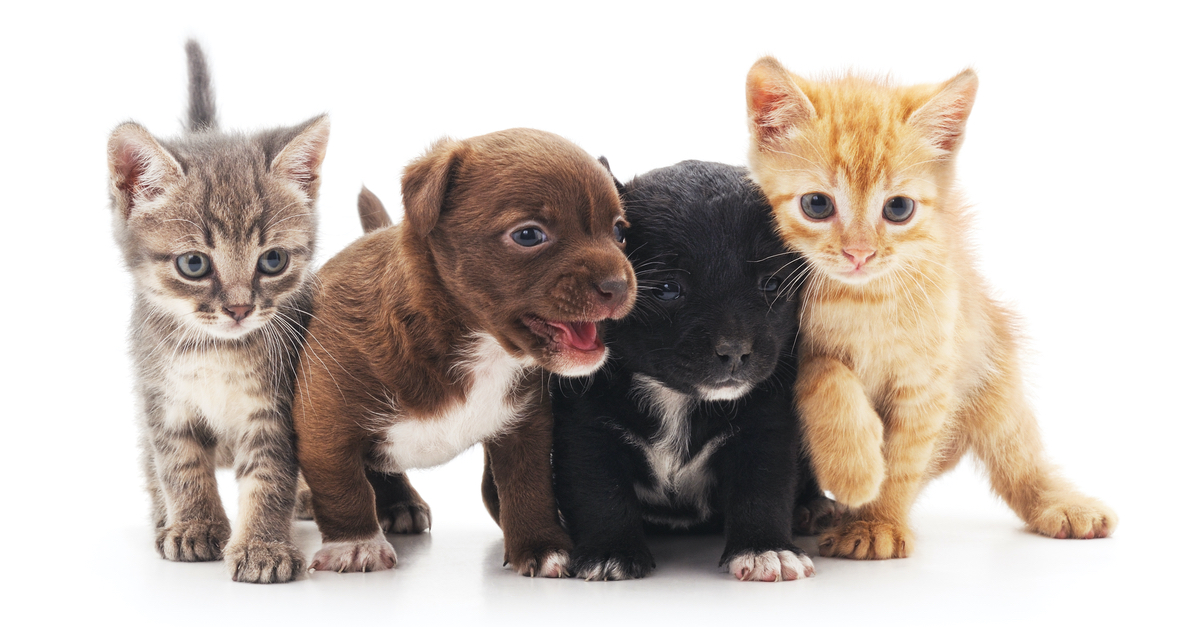Tails
Making pet parenting easy

How to start your puppy or kitten on a healthy diet
This entry was posted on 2023-05-24.
Figuring out the right diet for your new pet can be overwhelming. With so many brands and types of pet food on the market, it can be difficult to determine which contain the best nutrition for puppies and kittens. Puppies and kittens have different nutritional needs than their adult counterparts, and require a strong foundation to help prevent future diseases and obesity.
Most puppies and kittens are weaned by the time they arrive in their new home at 7 to 9 weeks old. At this time, nutrition for puppies and kittens must be formulated to support the growth and development of a new pet. Plus, the nutrition needs will change over the course of the first year and when the puppy or kitten matures into a full grown dog or cat. Cats and small/medium sized dogs will reach maturity from approximately 10-12 months, while large and giant breeds of dog will reach full size and maturity between 18-24 months.
The first step is to look at the packaging. The bag should provide information on the lifestage the diet is intended to support. In this case the label should state that the food is suitable for puppies (or kittens). The label should also include an ingredient list as well as the guaranteed analysis of the food (the amount of nutrients in the food).
5 Nutrients Puppy and Kitten Food Should Include
1. Energy
Puppies and kittens grow the most between 3 and 6 months, and their energy needs during the first 4 months are about twice that of mature animals of the same size. This metabolic energy requirement reduces gradually after the first 4 months. It also coincides with a second reduction in energy requirement following neutering (which is usually at 6 months of age). If calories are not reduced after neutering, the development of obesity is likely. By working with your veterinarian, you can look at the pet’s body condition score (BCS) to determine the best caloric requirements for your puppy or kitten.
Because of the high energy needs of pets during development, diets that support growth are generally higher in fat than maintenance diets for adult animals. Dietary fat provides not only essential fatty acids but also twice the amount of metabolic energy per gram than do protein and carbohydrates. Thus, increasing the amount of fat supplied in the diet allows for smaller amounts to be fed in order to meet energy requirements. Diets low in fats may be unable to provide the necessary nutrients in a small enough volume for the patient to consume.
2. Protein
Good nutrition for puppies and kittens includes protein. Protein provides essential and nonessential amino acids, as well as nitrogen, to the diet. Dietary protein provides structure for hair, nails, ligament, tendons, cartilage, and new tissue during growth. It also helps maintain a healthy immune system by supporting production of immunoglobulins and antibodies. Kittens require more protein than puppies and have 11 essential amino acids, compared to 10 in puppies. A high-quality protein source supplies all the essential amino acids, whereas a poor-quality protein source is limited in certain essential amino acids and will necessitate a second protein source to provide all the necessary amino acids.
3. Calcium and Phosphorus
Commercial foods should have the appropriate ratio of Calcium to Phosphorus (Ca:P between 1.1:1 and 1.5:1) to help maintain healthy levels in your pet. If you are feeding a properly balanced diet additional supplementation of Calcium is not required nor suggested, as too much of these nutrients is undesirable and may be harmful.
4. DHA
A good food with the appropriate nutrition for puppies and kittens will include this omega-3 fatty acid. It helps with retinal, neural and auditory development, affecting training and learning in puppies and kittens.
5. Antioxidants
Vitamins and minerals (such as vitamins A and C, β-carotene, lutein, zinc, and selenium) that acts as antioxidants support immunity in your puppy or kitten and are essential to a heathy diet.
Feeding Frequency
For puppies, start with 3-4 feedings per day, depending on the size of your dog. Smaller breed puppies may need more frequent feedings than their larger breed friends for the first 3 months. After the puppy period, discuss feeding frequency with your veterinarian to determine the best schedule for your adult dog’s needs.
For kittens, “free-choice” feeding is recommended until 5 months, then switching to 3-4 meals per day for an additional month. Kittens are then often switched to 2 meals per day through adulthood.
Transition from one feed to another
When changing foods, it is important to transition from one food the next gradually. Add a little bit of the new food each day, while reducing the amount of the old food over a 5-7 day period. This will help minimize digestive distress, and help your pet transition and accept the new food more easily.
Size and Life stage nutrition
Be sure to purchase food that is appropriate for your pet’s size and stage of life. Kittens and small/medium breed puppies can be fed an adult diet from their first birthday. Larger breeds of dogs need to stay on puppy food until they are 18-24 months old.


